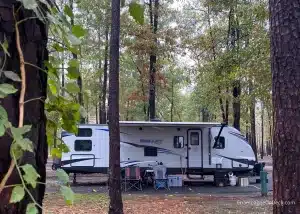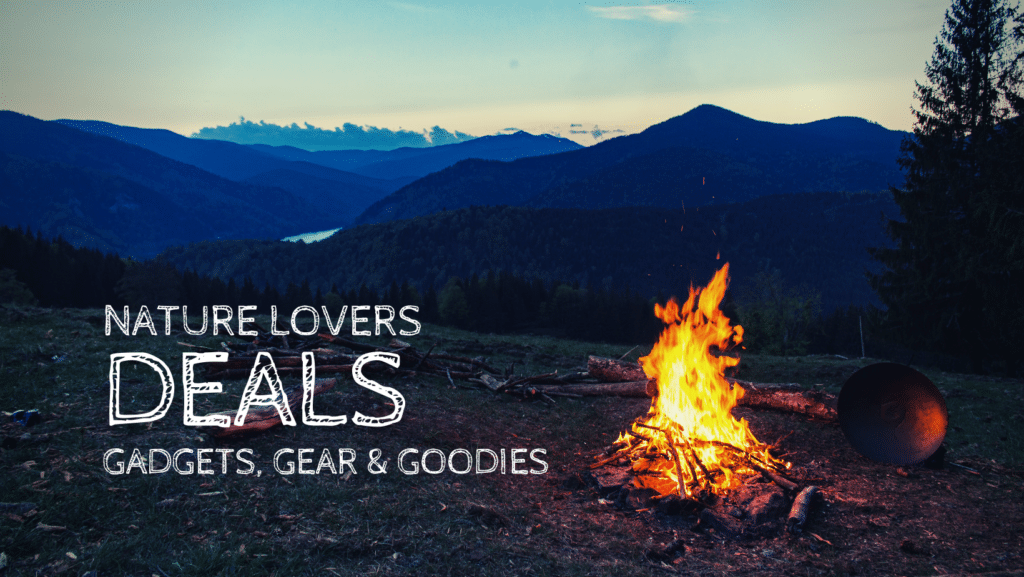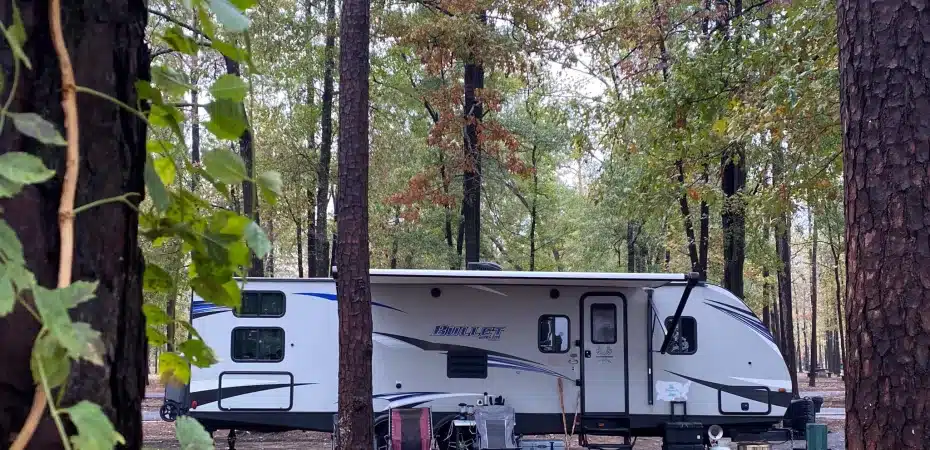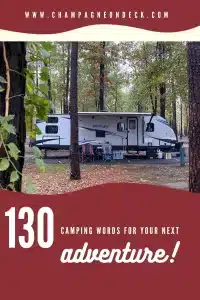Welcome to the ultimate guide for outdoor enthusiasts and novice campers alike! In the wilderness of camping knowledge, understanding camping words is like unlocking the secrets to a more enjoyable outdoor experience. In this comprehensive blog post, we’ve compiled a list of 130 camping words, each with its unique definition. From gear, RV parts, and shelters to activities and safety measures, this guide aims to unravel the language of camping. This camping word list will enhance your wilderness lexicon and elevate your camping expertise!

Disclaimer: This post contains affiliate links, including my Amazon Associate links. This means that I earn a small commission from qualifying purchases. All purchases made will come at no extra cost to you. Thank you so much for supporting my blog.
General Camping Words List
| Backpack: A bag with shoulder straps, often supported on the back, used for carrying personal belongings. |
| Backpacking: The activity of hiking and camping for an extended period, usually carrying one’s gear and provisions in a backpack. |
| Bear Bag: A container or bag used to store food and other items securely, suspended from a tree to prevent bears from accessing it. |
| Binoculars: Optical devices used for magnified viewing of distant objects, helpful for bird watching and wildlife observation. |
| Bivy Sack: A compact and lightweight outdoor shelter designed for solo adventurers, a bivy sack (short for bivouac sack) is a minimalist, waterproof, and breathable enclosure that offers protection for a sleeping bag and occupant. Typically resembling a small, tapered bag, a bivy sack is designed to provide a barrier against the elements, including rain and wind, while offering a breathable environment for the camper. Its portability and simplicity make it an excellent choice for backpackers and mountaineers seeking a quick and efficient shelter solution during outdoor expeditions. |
| Bug Spray: A substance applied to the skin or clothing to repel insects. |
| Camp Chair: A portable, foldable chair designed for outdoor use at campsites. |
| Camp Etiquette: Behavioral guidelines and manners observed by campers to ensure a positive and respectful camping experience. |
| Camp Stove: A portable cooking appliance designed for outdoor use, commonly fueled by propane or butane. |
| Camper’s Knot: A knot used in camping and outdoor activities for various purposes, such as securing gear. |
| Campfire: An open-air fire at a campsite, often used for cooking, warmth, and socializing. |
| Campground: A designated area with facilities for camping, often including campsites, amenities, and services. |
| Camping Gear: The equipment and supplies essential for a camping excursion, including tents, sleeping bags, cooking utensils, and other tools designed to enhance the outdoor experience. |
| Camping Trip: An outdoor recreational activity involving overnight stays in a tent, camper, or other temporary shelter, typically in natural settings such as forests, mountains, or campgrounds. |
| Campsite Selection: The process of choosing an appropriate location for setting up a camp, considering safety and environmental impact. |
| Campsite: A designated area where individuals or groups set up temporary accommodations for camping. |
| Car Camping: Camping that involves driving to a campsite and setting up temporary accommodations near or inside the vehicle. |
| Compass: A navigational instrument with a magnetic needle pointing toward the magnetic north. |
| Cooking Utensils: Tools and implements used for preparing and cooking food in an outdoor setting. |
| Daypack: A small, lightweight backpack used for day trips or shorter outdoor excursions. |
| Dehydrated Food: Food that has had the moisture removed, typically through a dehydration process, making it lightweight and easy to transport for camping meals. |
| Dome Tents: Tents with a dome-shaped structure, typically featuring flexible poles that cross over the top and extend down to the base, offering stability and spacious interior headroom. |
| Durable Water Bottle: A sturdy and resilient container for carrying water, essential for staying hydrated during outdoor activities. |
| Emergency Whistle: A loud signaling device used to attract attention in emergency situations. |
| Firewood: Wood used for fueling a campfire. |
| First Aid Kit: A collection of medical supplies and equipment for providing basic medical care in emergencies. |
| Fishing Line: A strong, flexible cord used for angling, an essential tool for fishing enthusiasts during camping trips near water bodies. |
| Flashlight: A portable hand-held electric light source. |
| Four-Season Tent: A sturdy and insulated tent designed to withstand various weather conditions, suitable for camping in all four seasons, including winter with snow and cold temperatures. |
| Frame Tent: A frame tent is a type of tent structure that is supported by a framework of metal or aluminum pipes or poles, rather than relying on center poles and stakes like traditional pole tents. The frame of the tent creates a skeleton-like structure, and the tent fabric is then stretched over this frame. This design allows for more open and unobstructed space inside the tent since there are no center poles. Frame tents are commonly used for various events such as weddings, parties, and outdoor gatherings where a clear, open interior space is desired. They are known for their versatility and can be set up on various surfaces, including concrete and asphalt, as they don’t require staking. |
| Freestanding Tent: A tent that can stand on its own without the need for stakes or guy lines, making it easy to set up and move to different locations within a campsite. |
| Gaiters: Protective coverings worn over the lower legs and footwear to prevent dirt, water, or snow from entering. |
| Gear Loft: An overhead storage compartment within a tent designed to hold small items, keeping them organized and easily accessible. |
| Ground Tarp: A waterproof or protective sheet placed on the ground under a tent to prevent moisture and damage. |
| Hammock: A swinging bed or couch made of canvas or rope netting, suspended between two points. |
| Headlamp: A hands-free light source worn on the head, useful for camping activities in low-light conditions. |
| Hiking: The activity of walking for long distances, especially across country or in the wilderness. |
| Ice Chest: An insulated container designed to keep perishable food items and beverages cool by preventing the entry of external heat. Typically made of durable materials like plastic or metal, an ice chest is equipped with a lid and a seal to maintain a low temperature within. Campers, picnickers, and outdoor enthusiasts commonly use ice chests to store ice packs or ice cubes, ensuring that food and drinks remain chilled during outdoor activities. The portability and efficiency of ice chests make them indispensable for keeping refreshments cold, especially in environments where refrigeration is unavailable. |
| Insect Repellent: A substance applied to the skin or clothing to deter and protect against insects, minimizing the risk of insect bites during outdoor activities. |
| Leave No Trace: A set of outdoor ethics promoting responsible recreation to minimize environmental impact. |
| Magnetic Needle: often referred to as a magnetic compass needle, is a crucial tool used in camping and outdoor activities for navigation. It is a lightweight and portable instrument that helps campers determine their direction with respect to the Earth’s magnetic field. The key components of a magnetic needle include a thin, magnetized needle or a magnetized bar that is free to pivot. |
| Map and Compass Navigation: The skill of using maps and compasses to navigate and find direction in outdoor environments. |
| Marshmallow Roasting: The enjoyable activity of toasting marshmallows over an open flame, often done during camping. |
| Multitool: A versatile tool that combines various functions, such as a knife, pliers, and screwdriver. |
| National Park: A national park is a designated area of land, typically owned and protected by a government, that is set aside for the preservation of its natural beauty, unique ecosystems, and cultural or historical significance. National parks aim to conserve and showcase the diverse landscapes, wildlife, and geological features within their boundaries. These areas often provide opportunities for outdoor recreation, education, and scientific research while emphasizing the importance of environmental conservation. National parks are established with the goal of ensuring that these natural treasures remain intact and accessible for present and future generations to enjoy. |
| Outdoor Cooking: The practice of preparing meals outside, often using portable stoves, grills, or open fires. |
| Picnic Table: A sturdy table located in outdoor settings, often at campsites or picnic areas, designed for eating and socializing during outdoor activities. |
| Pole Sleeves: Fabric coverings or sheaths that protect the tent poles, adding durability and preventing wear and tear during setup and takedown. |
| Portable Light: A compact and easily transportable source of illumination, such as a lantern or flashlight, essential for providing light during nighttime camping activities. |
| Portable Stove: A compact and portable cooking device designed for outdoor use, fueled by propane, butane, or other camp-friendly energy sources. |
| Portable Water Filter: A device used to purify water by removing impurities, making it safe for drinking. |
| Pup Tent: A pup tent is a small, lightweight tent typically designed for one or two people. It is characterized by its simple and compact structure, making it easy to set up and transport. The term “pup tent” is often associated with military use, and historically, it referred to a small tent used by soldiers in the field. Pup tents are usually A-frame in shape, supported by two vertical poles at each end, and have a ridge line that connects the two poles. While they may vary in design, the common feature is their small size and practicality for quick and temporary shelter, suitable for camping or backpacking. |
| Rain Fly: A waterproof cover that attaches to the exterior of a tent to provide additional protection against rain and moisture. |
| Remote Locations: Areas that are situated far from urban centers or developed regions, often chosen for camping trips to experience solitude and a closer connection with nature. |
| Scavenger Hunt: An outdoor game or activity where participants search for and collect specific items or complete challenges based on a provided list, adding an element of adventure to the camping experience. |
| Shelter: A place that provides protection from the elements, such as a tent, cabin, or other structure made of strong material. |
| Sleeping Bag: A portable, insulated bag for sleeping, typically used in camping to provide warmth. |
| Sleeping Pad: A cushioned mat placed under a sleeping bag for comfort and insulation from the cold ground. |
| Solar Charger: A device that uses solar energy to charge electronic devices, useful for camping in remote areas. |
| Stargazing: Observing celestial objects and phenomena in the night sky. |
| Telescope: optical instrument designed for observing distant objects by collecting and magnifying light. They come in various types and designs, but the basic principle involves the use of lenses or mirrors to gather and focus light, enabling a closer and clearer view of celestial or terrestrial objects. |
| Temporary Shelter: A quickly assembled structure providing protection from the elements, often used during camping trips and designed for short-term use. |
| Tent: A portable shelter typically made of fabric or similar material supported by poles and stretched tight by cords or stakes. |
| Thermos Bottle: A vacuum-insulated container designed to keep beverages hot or cold, often used during camping trips to maintain the temperature of drinks. |
| Trail Mix: A mixture of nuts, dried fruits, and other snacks, often carried as a convenient and energy-boosting trail food. |
| Trail: A path or track made for walking, hiking, or running, often in a natural environment. |
| Trekking Poles: Adjustable poles used to provide stability and support during hiking or trekking. |
| Water Purification: The process of treating water to remove contaminants and make it safe for consumption. |
| Waterproof Bags: Containers or sacks designed to protect contents from water, ensuring that essential items, such as clothing or electronics, remain dry during outdoor activities, especially in wet conditions. |
| Weather Forecast: Predictions about the atmospheric conditions, crucial for planning outdoor activities. |
| Wilderness: An area of undeveloped or uncultivated land, often in its natural state with minimal human impact. |
| Wildlife Awareness: Being conscious of and respecting the presence of wildlife in natural environments. |
| Wildlife Conservation: The protection and preservation of wildlife and their habitats. |
| Wildlife Tracking: The skill of identifying and interpreting signs of animal presence in natural environments. |
RV Specific Camping Words List
| Awning: A retractable shade or cover attached to the side of an RV to provide shelter from the sun or rain. |
| Back-in Site: A type of RV campsite where occupants must maneuver their vehicle in reverse to position it into the camping space. Back-in sites often require precision and skill in backing up the RV into the designated spot. |
| Blackwater: Wastewater from the toilet in an RV, containing human waste. |
| Boondocking: Camping in an RV without access to traditional campground amenities, often in remote or undeveloped areas. |
| Camper Van: A compact van converted into a mobile living space for camping and travel. |
| Class A: A category of large, luxurious motorhomes typically built on a commercial bus chassis. |
| Class B: A category of smaller motorhomes, often converted vans with built-in living accommodations. |
| Class C: A category of motorhomes with a distinctive over-cab sleeping area, usually built on a van or truck chassis. |
| Diesel Pusher: A type of motorhome with a rear diesel engine, providing more power and a quieter ride. |
| Dump Station: A facility at campgrounds or RV parks where waste tanks from RVs can be emptied. |
| Fifth Wheel: A type of RV that is towed by a pickup truck using a specialized hitch mounted in the bed. |
| Full Hookup: The connection of an RV to essential utilities such as water, electricity, and sewer facilities at a campground. |
| Generator: A device that produces electrical power to run appliances in an RV when shore power is not available. |
| Greywater: Wastewater generated from sinks, showers, and kitchen appliances in an RV. |
| Holding Tanks: Containers in an RV that store greywater and blackwater until they can be properly disposed of. |
| Inverter: A device that converts DC power from RV batteries into AC power for electronic devices. |
| Leveling Blocks: Blocks or pads placed under RV tires or jacks to level the vehicle on uneven terrain. |
| Motorhome: A self-propelled RV that combines living quarters with a motorized chassis. |
| Pop-up Camper: A foldable camper that collapses for towing and expands for camping. |
| Propane: A fuel commonly used in RVs for cooking, heating, and powering appliances. |
| Pull Through Site: A type of RV campsite that allows campers to drive straight through the site without the need for backing up. Pull-through sites are generally more convenient for larger RVs or individuals who prefer an easier entry and exit process without the need for intricate maneuvering. |
| RV (Recreational Vehicle): A motorized or towable vehicle designed for living accommodations, commonly used for camping, travel, and recreation. |
| RV Air Conditioner: An air conditioning unit designed for installation in an RV. |
| RV Awning Lights: Decorative lights attached to the awning of an RV for nighttime ambiance. |
| RV Backup Camera: A camera system installed on an RV to assist in backing up and maneuvering. |
| RV Battery: A battery or set of batteries used to power DC appliances and systems in an RV. |
| RV Camping: RV camping refers to the recreational activity of utilizing a recreational vehicle (RV) as a mobile accommodation for outdoor adventures. In RV camping, individuals or families travel to various destinations, ranging from campgrounds and national parks to remote locations, while bringing along their motorhomes, travel trailers, or camper vans. This form of camping combines the comforts of home with the freedom to explore diverse landscapes, offering amenities such as sleeping quarters, kitchens, and bathrooms within the RV. RV camping allows enthusiasts to enjoy the great outdoors while retaining the convenience and flexibility of a self-contained living space on wheels. |
| RV Campsites: Designated areas equipped to accommodate recreational vehicles (RVs), providing facilities and amenities such as electrical hookups, water connections, and often sewage disposal, allowing RVers to set up temporary living spaces. |
| RV Cover: A protective cover designed to shield an RV from the elements when not in use. |
| RV Dining Table: The table in an RV’s living area used for dining and other activities. |
| RV Furnace: A heating system designed for use in RVs. |
| RV GPS: A global positioning system designed for navigation in RVs, considering factors like height and weight restrictions. |
| RV Hitch: A coupling device that connects an RV to a tow vehicle. |
| RV Jack: A mechanical device used to lift and stabilize an RV for leveling or tire maintenance. |
| RV Mattress: A mattress designed for use in RVs, often accommodating space limitations. |
| RV Park: A designated area or facility specifically designed to accommodate RVs, providing various amenities and services. |
| RV Refrigerator: A specialized refrigerator designed for use in RVs, often able to run on multiple power sources. |
| RV Roof: The top exterior surface of an RV, often equipped with vents and fixtures. |
| RV Shower: The bathroom facility in an RV equipped with a shower. |
| RV Slide Topper: A fabric covering that extends over an RV slide-out to protect it from the elements. |
| RV Slide: A movable section of an RV that expands to create additional interior space when parked. |
| RV Stabilizers: Devices used to reduce movement and rocking when an RV is parked. |
| RV Steps: Portable steps used for easy access to the entrance of an RV. |
| RV Sway Bar: A device used to reduce swaying or oscillation of an RV during travel. |
| RV Toilet: A specialized toilet designed for use in RVs, often with waste disposal systems. |
| RV Towing: The process of pulling a trailer or towable RV with a separate vehicle. |
| RV Vent: A ventilation system in an RV for airflow and temperature control. |
| Satellite Dish: A device used to receive satellite television signals in an RV. |
| Sewer Hose: A flexible hose used to empty the blackwater and greywater tanks from an RV. |
| Shore Power: The external supply of electricity to an RV from a campground or external power source. |
| Slide-out: A movable section in an RV that can extend outward to increase interior space when the vehicle is parked. |
| Toy Hauler: An RV with a designated space for transporting recreational vehicles such as ATVs or motorcycles. |
| Water Heater: An appliance in an RV that heats water for various uses, such as bathing and washing dishes. |
| Water Hook-up: Connecting an RV to a water source at a campground or RV park. |
Camping Words Conclusion
Camping words hold a special place in the hearts of outdoor enthusiasts, creating a lexicon that captures the essence of nature and adventure. Whether it’s the crackling of a campfire or the serene whispers of a forest breeze, camping words transport us to the tranquil beauty of the great outdoors. Happy camping!
Pin Camping Words Post
Save this post of camping words to reference later by Pinning it!
Now that you are well versed in camping words, check out our inspirational post on 100+ outdoor activities!
Facebook Group
The Best RV Accessories and Camping Supplies Deals
Follow my Facebook Page, “Champagne On Deck Finds It” or join our Facebook community group. Here I post camper related deals. You can even request items and I will do the deal searching for you! I love it.

Follow me on Instagram and subscribe to my blog below. This way you won’t miss any of our travel adventures to inspire your own future road trips.
Subscribe
Comments
Did I miss any camping words that should be added to this list? Let me know what you would add in the comments below.

